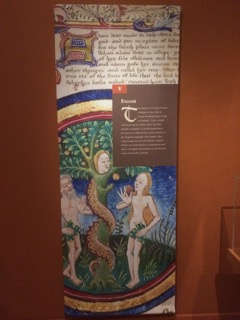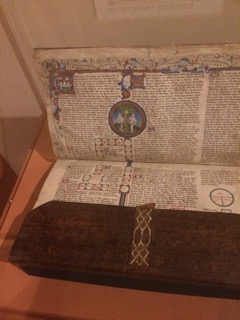 The Center for Jewish History in NYC is currently showing an exhibit of Hebrew, Greek, and Anglo-Saxon manuscripts from Corpus Christi College, Oxford, celebrating its quincentenary. This is the first time Hebrew, Greek and Anglo-Saxon manuscripts and other objects (e.g. the crozier of the founder of the College, Bishop Richard Fox) have crossed the pond.
The Center for Jewish History in NYC is currently showing an exhibit of Hebrew, Greek, and Anglo-Saxon manuscripts from Corpus Christi College, Oxford, celebrating its quincentenary. This is the first time Hebrew, Greek and Anglo-Saxon manuscripts and other objects (e.g. the crozier of the founder of the College, Bishop Richard Fox) have crossed the pond. Corpus has the ‘most important collection of Anglo-Jewish manuscripts in the world’, says the PR and worth seeing are survivors from pre-Expulsion era manuscripts of Hebrew and Latin, one a private 12th-century Ashkenazi siddur (book of daily prayers), thought to be the oldest extant anywhere, that was owned by a Sephardic Jew from the Iberian Peninsula who emigrated to England and wrote notes on his business dealings in Judeo-Arabic. There is a 13th-century manuscript of Samuel and Chronicles that was used by Christians to learn Hebrew, and two of the oldest manuscripts of Rashi in the world. There is also a version of Chaucer's Canterbury Tales, a Langland, a version of Wycliffe's translation of the Bible and other notable manuscripts.
 The 1611 Authorized Version of the Bible, also known as the KJV is arguably the most important translation of the Bible into English. The college's role in the creation of the King James Version is a key part of its history, which is represented here by handwritten notes. John Rainolds, the president of Corpus Christi, first proposed the Bible's creation to King James and led one of the six committees that produced it. This manuscript records notes from the translators of the King James Bible by John Bois. The notes run to thirty-nine pages and are the only record of some of the deliberations and preferences of the translators. It is a record of the sheer diligence of the translators, comparing, discussing and consulting authorities. The Preface to the Translation explains this work of revision. 'Neither did we disdain to revise that which we had done, and to bring back to the anvil that which we had hammered: but having and using as great helps as were needful, and fearing no reproach for slowness, nor coveting praise for expedition, we have at the length, through the good hand of the Lord upon us, brought the work to that pass that you see'.
The 1611 Authorized Version of the Bible, also known as the KJV is arguably the most important translation of the Bible into English. The college's role in the creation of the King James Version is a key part of its history, which is represented here by handwritten notes. John Rainolds, the president of Corpus Christi, first proposed the Bible's creation to King James and led one of the six committees that produced it. This manuscript records notes from the translators of the King James Bible by John Bois. The notes run to thirty-nine pages and are the only record of some of the deliberations and preferences of the translators. It is a record of the sheer diligence of the translators, comparing, discussing and consulting authorities. The Preface to the Translation explains this work of revision. 'Neither did we disdain to revise that which we had done, and to bring back to the anvil that which we had hammered: but having and using as great helps as were needful, and fearing no reproach for slowness, nor coveting praise for expedition, we have at the length, through the good hand of the Lord upon us, brought the work to that pass that you see'.This (Corpus Christi Ms 207) is a royal genealogy in Middle English for all the medieval kings of England from Adam and Eve to Edward IV (1433-83). It was written and illuminated in England probably in Winchester or London 1467-69.
Below is a page from The Lapworth Missal. Misal, Use of Sarum. England, dated 1398. The Lapworth Missal, with its 14th-century illustration of the crucifixion, "is the most artistically significant item in the exhibit—and the gold is spectacular" according to the catalog.
You have until August 6th 2017 to catch this remarkable display.

